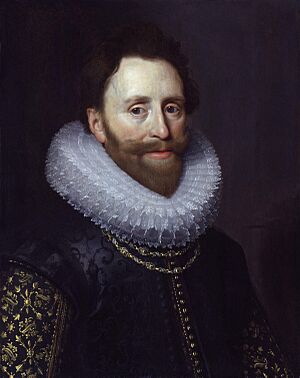Dudley Carleton, 1st Viscount Dorchester facts for kids
Dudley Carleton, 1st Viscount Dorchester (born March 10, 1573 – died February 15, 1632) was an important English diplomat and politician. He was also known for collecting art. He served as a Secretary of State, which was a very high-ranking government job.
Contents
Dudley Carleton's Early Life and Education
Dudley Carleton was born in Brightwell Baldwin, Oxfordshire. His parents were Anthony Carleton and Joyce Goodwin. He went to Westminster School and then to Christ Church, Oxford university. He earned his first degree in 1595 and a master's degree in 1600.
After university, he worked as a secretary for Sir Edward Norreys. He also joined a diplomatic trip to Paris in 1598. Later, he worked for the English ambassador in Paris, Thomas Parry. He then joined the household of Henry Percy, 9th Earl of Northumberland.
Carleton in Parliament
In 1604, Carleton became a member of the English Parliament. He often supported the king's views, even when they were not popular with everyone.
Linked to the Gunpowder Plot
In 1605, Carleton's name was linked to the famous Gunpowder Plot. This was a plan to blow up the Parliament building. Carleton was out of the country when the plot was discovered. The plotters had used his name to rent a house near Parliament.
When he returned to England, Carleton was held for about a month. However, he was released because Robert Cecil, 1st Earl of Salisbury helped him. Cecil knew that Carleton had been stuck in Paris and was not involved in the plot.
Serving as an Ambassador
Dudley Carleton became a knight in 1610. This was a special honor from the king. He was then sent to Venice, a city in Italy, as an ambassador. An ambassador is a diplomat who represents their country in another country.
Ambassador in Venice
In Venice, Carleton helped to complete an important peace agreement called the Treaty of Asti. He also dealt with many religious matters. He helped people who were in trouble with the religious authorities there. He also helped the king get a report on religious ideas from a famous scholar named Paolo Sarpi.
Carleton was very interested in art. He started looking for artworks for Charles, who was then the Duke of York, and other important English nobles. He helped bring Italian art and ideas about travel (called the Grand Tour) to England's upper class.

Ambassador in the Netherlands
Carleton returned to England in 1615. The next year, he was appointed ambassador to the United Provinces (what is now the Netherlands). This was a very important job because relations between England and the Netherlands were key to England's foreign policy. Carleton worked hard to make these relations better.
He also got involved in a big religious debate happening in the Netherlands. He supported one side of the debate, which was in line with the English king's views. He helped arrange a big meeting called the Synod of Dort to settle these religious questions.
While in the Netherlands, Carleton continued his interest in art. He traded marble sculptures for paintings with the famous artist Rubens. He also helped other important English art collectors get paintings from artists like Daniel Mytens and Gerard van Honthorst.
As a war started in Europe (the Thirty Years' War), Carleton realized that his diplomatic efforts had limits. The English king and the Dutch leader had different ideas about how to help Frederick V, Elector Palatine, who was related to both of them. Frederick and his wife, Elizabeth of Bohemia, even took refuge in Carleton's house in The Hague in 1621.
Carleton's Return to England and Peerage
In 1625, Carleton returned to England with George Villiers, 1st Duke of Buckingham, a powerful friend of the king. Carleton was given two important jobs: Vice-Chamberlain of the Household and a privy councillor.
In the House of Commons and Lords
He then went on a mission to France to help the Huguenots (French Protestants) and try to form an alliance against the House of Habsburg. When he came back in 1626, he found that Parliament was focused on criticizing his friend, the Duke of Buckingham. Carleton tried to defend Buckingham and supported the king's power.
Soon after, in May 1626, Carleton was given a special honor: he became a peer. This meant he was given the title of Baron Carleton of Imber Court and moved from the House of Commons to the House of Lords.
He was sent on another mission to The Hague. When he returned in July 1628, he was given an even higher title: Viscount Dorchester.
Secretary of State
In December 1628, Viscount Dorchester became the principal Secretary of State. This made him a very important figure in King Charles I's government, especially during the time known as the Personal Rule, when the king ruled without Parliament. He was in charge of foreign policy.
Dudley Carleton died on February 15, 1632, and was buried in Westminster Abbey.
Carleton's Important Letters
Dudley Carleton's many letters are very important for understanding the history of foreign affairs between 1610 and 1628. His letters from his time as ambassador in The Hague were published in 1757. Many of his other letters are still in old government records.
He regularly wrote to his friend John Chamberlain, and many of their letters still exist. These letters give us a lot of information about how important people in that time helped each other and got jobs.
Family Life
Dudley Carleton married Anne Gerrard in November 1607. She was a widow. Anne died in 1627, and they did not have any children who lived.
In 1630, he married another woman named Anne Glemham, who was also a widow. They had one child who died young. When Dudley Carleton died, his title of Viscount Dorchester ended with him because he had no living children to inherit it.
See also
- Baron Dorchester
- Viscount Bayning
- Secretary of State (England)
- Vice-Chamberlain of the Household
- Privy council



